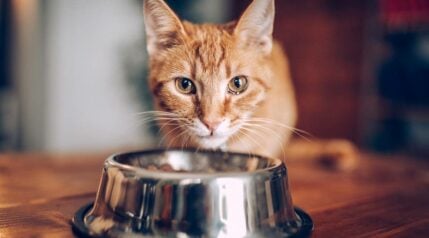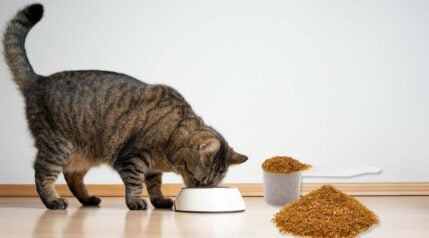When you purchase through links on our site, we may earn a commission. Here’s how it works.
We naturally want to share delicious, healthy treats with the ones we love. When our loved ones include cats, we need to consider whether or not the treat that’s healthy and delicious to us will also be safe for them. The natural diet of the felines still existing in the wild is comprised of various small animals and insects, but domesticated cats enjoy much more mundane fare.
A cat’s health depends on a diet with the proper proteins, vitamins, and minerals, and there’s room for variety. One cat may turn up his nose at almost every meal presented to him, while another cat may be willing to try anything. Often, commercially prepared foods include a range of ingredients that one would not find in the natural feline diet to meet all a cat’s dietary requirements. Cats in the wild ingest not only muscle meat but bone, hair, and all other parts of what they catch. Commercial diets seek to replicate a natural diet by including a range of ingredients and supplements.
Modern cat food formulas often include fruits, grains, and berries beyond the base of animal protein. Although they are carnivores, we can also offer fresh fruit to our cats. We may not be sure what is safe to provide fresh or in what quantity the fruit can be offered. Some fruits, and some fruit seeds, are toxic to cats. Mangos, thankfully, are safe for cats in moderate amounts, although their large pit could be considered a choking hazard.
Can Cats Eat Mango?
If cats are offered a variety of treats, they would generally choose a savory meat treat like salmon or chicken. Many cats do enjoy a wider variety of fare. Not every cat will warm to an offering of mango, but if you share a slice, you can feel comfortable that mango is safe for cats to eat. It is even an ingredient in some commercially prepared foods, although not as common as blueberries, cranberries, and pumpkins. Various fruits have been added to pet diets for their vitamins and potent antioxidant properties from polyphenols and carotenoids. Mangos contain a substantial dose of both.
Mangos contain sugars, and obesity is one of the leading causes of poor pet health today. Monitor your cat’s body condition to be sure he does not gain excess weight. Mangos are higher in natural sugars than most other fruits, with forty-six grams of sugar in a single mango, compared to an avocado, which has a mere 1.33 grams. Balance your cat’s diet with plenty of exercise to keep him at a healthy weight. If your cat likes mango, offer it in very small amounts and only as an occasional treat.
Is Mango Good For Cats?
Mangos are high in polyphenol and carotenoid content, both powerful antioxidants. They contain dietary fiber as well. Cats need fiber in their diets for healthy digestive function. Adding fiber to commercially produced kibble can assist with both constipation and diarrhea by regulating the water in the gut and helping stabilize the consistency of the cat’s stool. About 61% of fiber in mangos is soluble fiber, while the remaining 39% is insoluble. When soluble fibers dissolve in the stomach, they can turn into a gel that makes stools easier to pass. Insoluble fibers regulate food transport through the system and may help with stool consistency.
Feeding beneficial fiber to promote a healthy balance of bacteria in the gut helps recovery after some illnesses. For diabetic cats, adding fiber may help the sugars from starches to be absorbed more slowly, helping stabilize blood sugar levels. Unfortunately, with mangos, the high amount of sugar in the fruit may counterbalance the benefit of the fiber.
The beta carotene in mangos make them a good source of vitamin A, a powerful antioxidant. They contain vitamin C, as well. Mangos contain a variety of phenolics like ellagic acid, gallotannin, and mangiferin, a phenolic specific to mangos. Phenolics serve as a base to antioxidants, which help repair the oxidation of free radicals – cells that cause diseases like cancer or diabetes. Mangiferin and ellagic acid possess anti-inflammatory and anti-cancer properties, and gallotannin, which provides cardiovascular protection and has antioxidant and antibacterial properties.
What’s The Best Way To Share Mango With Your Cat?

If your feline best friend likes to try new things, you can offer a small amount of mango. Make sure you peel and chop it into bite-size pieces. Serve the mango fresh or dehydrate it, but avoid commercially prepared dried mango that may contain added sugar. Chilled mango in the summertime provides a refreshing snack for your cat.
There are multiple varieties of mango, but the two most common in the United States are the more popular Tommy Atkins variety and the golden Ataulfo. The Ataulfo is sweeter and likely more palatable. As with many fruits, the peel contains high concentrations of beneficial nutrients, so your cat can chew slices with the peeling attached. The peel is more fibrous and may satisfy his need to chew.
Although the seeds and pits of some fruit have toxic properties, mango kernel, the inner part of the seed beneath the husk, has significant nutritional properties. Although studies suggest economic benefits to increasing the utilization of this generally discarded part of the mango, it remains underutilized. Like many fruits, the skin of the mango contains high concentrations of nutrients. Mango skin is not toxic to pets but tastes unpleasant.
Mango skin contains urushiol, which is the same chemical in the poison ivy plant that triggers a rash. If you purchase mangos and have a poison ivy allergy, wash the urushiol from the mango with warm water and a gentle brush to limit your chance of having an allergic reaction.
Final Thoughts
We want to share good times and good food with those we love, and we love our cats. Not all treats are created equal. Offering your cat some safe foods with unusual tastes and textures helps alleviate boredom and augments a varied and healthy diet. Mangos offer vitamins and antioxidants above and beyond the animal-based proteins that make up the bulk of a carnivore’s diet. It’s safe to offer your feline friend small pieces of mango as a treat from time to time, but closely monitor his weight. You’ll add variety to his diet while providing healthy fiber and antioxidants.





